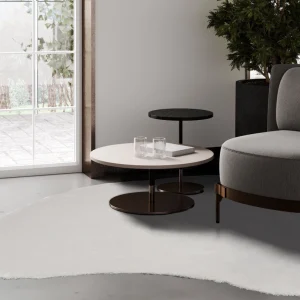
CAN YOU ENVISAGE a time when building new structures out of steel and concrete will be prohibited? A time when, perhaps, newbuilds might be allowed only so long as their materials are predominantly or entirely salvaged, circular, renewable or repurposed? Otherwise, refits or retrofits will rule. Blue-sky thinking? Not if the worlds’ architecture and construction industries aim to meet their zerocarbon ambitions. The UK’s Royal Institute of British Architects, for example, asks members to sign up to its 2030 Climate Challenge. Developed in conjunction with the Green Construction Board and built environment professionals, participating practices can download data collection spreadsheets to calculate their progress along defined lines, including reducing operational energy, embodied carbon and creating buildings that improve health and well-being. Other countries are far ahead of the UK – Belgium and Holland, in particular, have achieved breakthroughs in circular economy initiatives.
Achieving these objectives is going to require massive changes across the profession and its related industries. But you don’t have to look far to see a shift in tone, with a far greater proliferation of ambitious reuse and retrofit projects both winning international awards and filling the industry publications. Now even large-scale developers are trying to think more sustainably, according to Feix & Merlin, a young practice that has established a reputation for pushing diversity and inclusivity, as well as shown great flair for creatively reusing and repurposing both furnishings and buildings. You might expect forward-thinking local authorities and universities to be getting behind sustainability objectives, as Feix & Merlin has found both with their revamped Walworth Town Hall scheme for Southwark Council, and an ambitious scheme with David Chipperfield Architects to breathe new life into an existing LSE building on Lincoln’s Inn Fields – for which Feix & Merlin’s proposed a breathtaking, timber-lined auditorium to be inserted into the existing envelope. But they are also finding UK mega-developer British Land more sympathetic to the cause, including in its London HQ that Feix & Merlin is refurbishing. Says co-director Julia Feix: ‘We work with British Land quite a bit and they are very rigorous in making sure that sustainability is being considered in terms of materials. For their HQ fit-out they have supported us in being very stringent in terms of what we could use.’ While corporate developers in general ‘move slowly’, says Feix, when it comes to British Land, ‘the overall appetite for sustainable practice is very high. They need to be seen to be that sort of company, these days.’
So, with clients increasingly open to the idea that sustainable practice is the right thing to do, how can boundaries be pushed for doing more with what we’ve got. Husbandry of resources, luckily, is a topic that architects and designers have had to address for some time, what with global recessions, pandemics and now climate crisis conversations ramping up the pressure to do the right thing.
While the schemes that make the headlines often incorporate historic structures, retrofit first is increasingly the chosen option when the buildings are of indifferent aesthetic quality, but still robust.
Feilden Clegg Bradley (FCB) has demonstrated beautifully what can be achieved when a handsome, historic building is thoughtfully refurbished, and made fit for 21st-century audiences with just a few strategic interventions. I raved about its new Brighton Dome project in my FX Brief Encounters column for March 2024, and an earlier scheme for Alexandra Palace in north London has won a multitude of awards and admirers. But these buildings had glamour and cultural kudos to start with. Shrewsbury Flaxmill (see case study, below) shows what can be achieved in a more practical, yet still landmark industrial building with the right care and craftsmanship. However, retrofit as a default now means that even the lowliest of teaching or office spaces is worthy of another few decades’ occupation with the right approach. FCB partner Joe Jack Williams says: ‘The Flaxmill was always going to be saved. It’s an internationally important building – the grandfather of the skyscraper – and it’s listed so we had to preserve it.
‘Whereas we’ve just finished a project for the University of Plymouth to extend and retrofit a 90s building on the campus (the Babbage Building, now a state-of-the-art teaching and research space for engineering and design). It doesn’t have that craft or heritage feel, but with retrofit you still have to apply the same principles, and in doing so we have saved thousands of tonnes of CO2.
‘At the other end of the scale we have just done a retrofit for BRE, which is mostly an internal fit-out job. We did their HQ a while back. But with this building, there was a rigorous process of thinking through what can we keep, what has value. It’s just a tired 1960s office, but we thought, rather than replace it, can we just make it work harder? So, for example, we are turning carpet tiles into ceiling tiles. And luckily we found a lighting manufacturer that was happy to do repurpose the lighting, which is now all low-energy.’
Some iconic institutions have long been revealing outstanding new spaces within their old envelopes. The V&A’s Kensington building is permanently evolving, thanks to its ambitious FuturePlan development programme, The latest area to be transformed for visitors is the second phase of the Photography Centre (see case study, below), making this the UK’s largest permanent space dedicated to photography.
For commercial clients, reusing buildings of character, and broadcasting the environmental benefits, is now not only helping to attract a certain kind of client or occupant but that message of sustainability is helping to build new communities. Developers Fabrix have been refurbishing and reprogramming buildings set within a 20th-century film studio in Berlin into a mixed, creative campus, with high sustainability and well-being credentials, called Atelier Gardens (see case study). Only four years into the programme, around 42% of let office space has been occupied by social impact tenants, including Thinkfarm, Travelling U, Fridays for Future, and Roots Radicals, which enjoy being part of this crossdisciplinary creative community, along with Netflix, YouTube, ITV Studios and Berlin Met film School.
The Belgian government has been pushing the circular economy for the past decade, for all industries and sectors, including supporting the growth of Rotor, a construction industry portal that offers details of building components becoming available for reuse when demolition is scheduled. And these initiatives are catching on. Says FCB’s Joe Jack Williams: ‘There are companies trying to offer something like that.’ He cites Salvo (through which Material Works Architecture managed to source many of the furnishings and features of its almost entirely salvaged refit for Sustainable Ventures, see my FX column in the May issue). ‘But to reuse fully, you need to do a proper pre-demolition audit, so you know what’s useful. We are starting to see lots of money pouring into this area. There’s a company called Madaster, creating a software platform for recycling. There are now pan-European circular economy initiatives. And we are moving forward with materials passports.’
Fletcher Priest – whose Warwick Court retrofit project, featured in a previous edition of FX, opted for 90% retention and reuse of materials either from the site or nearby – has been pushing the practice of passporting materials, so that in future refits or reconstructions it’s possible to identify how to reuse each component properly. The prototype for this technology is 100 Fetter Lane, a 94,000ft2 newbuild conceived in the midst of the pandemic as a benchmark for sustainability and well-being. Working closely with sustainability consultants Watermans, a framework was developed to label all of the components clearly for future users. Although concrete and steel are the main construction materials, through modular and precast construction the frame and façade elements are designed to be easily dismantled and reused. Says Mark Sutton, senior associate at Fletcher Priest: ‘We’re adopting this now in the majority of our projects.’ And demand from both clients and tenants of these new future-facing office buildings is driving momentum, he adds.
To what extent is the construction industry evolving its thinking and practices to support this shift? FCB’s Williams says: ‘There are a couple of key stakeholders that need convincing: the main contractors and quantity surveyors. They are the gatekeepers for this. It’s not that they are not engaged, they just don’t have the tools – the ISO standards etc. They fall back on the bureaucratic, “low-risk” approach even though those practices are high risk for the environment. But they are getting there.’
CASE STUDY – BUITENPLAATS BRIENENOORD, ROTTERDAM
 Image Credit: Frank Hanswijk
Image Credit: Frank Hanswijk
Buitenplaats Brienenoord, located on an island in Rotterdam is a testament to Rotterdam architects Superuse Studios’ belief in the transformative power of re-using materials and collaborative practice.
The components used come from an abandoned scouting building, the Kamphuis, constructed by volunteers in the 1930s as a summer camp for local girls and boys, with both the building and its island location donated by Wilton Feijenoord, a historic shipping and repair company.
Up until 2000 the Kamphuis wa rented out for summer camps and holiday activities for school and community groups. However, a fire in nearby Volendam brought fire safety officers to the location, who declared the building unsafe. The hut and the island lay more or less unused until 2015, when a team of social, scientific and cultural activists identified its potential, redeveloping the site as Buitenplaats Brienenoord, an informal urban park where all members of Rotterdam’s population can gather in this peaceful and pastoral setting.
 Image Credit: Frank Hanswijk
Image Credit: Frank Hanswijk
Superuse Studios’ research began with an in-depth study of the existing building and its materials, identifying opportunities for reuse, followed by the collaborative process of reimagining the space to align with its new purpose. All the suitable materials from the former scouting building were salvaged and repurposed.
The new building’s foundations are based on the existing foundations, hence its not quite orthogonal shape. Steel trusses from the old building have been re-used, reinforced with wood or welded parts where necessary. In total 90% of recycled materials were used in its construction, almost all the materials salvaged from demolitions in the surrounding area, including radiators and doors.
Client Foundation Grondvesten
Design Superuse Studios
Construction began August 2015, completed September 2019
Gross floor area 329sqm
Construction costs Euros300,000
CASE STUDY – SHREWSBURY FLAXMILL
 Image Credit: Daniel Hopkinson
Image Credit: Daniel Hopkinson
The world’s first iron-framed building, Shrewsbury Flaxmill Maltings, has been reinvented as a leisure destination, museum and adaptable workspace after a £28m restoration programme, funded by Historic England, which bought the structure in 2005, rescuing it from decades of dereliction. Built between 1796–1797, the site consisted of eight Grade I listed buildings, four of which have been brought back to life.
 Image Credit: Daniel Hopkinson
Image Credit: Daniel Hopkinson
For almost 100 years it operated as a steam-powered flax mill, its innovative iron frame designed to minimise fire risk, paving the way for subsequent skyscraper design. The cast iron frame had cracked due to settlement, and as its Grade I listing meant it could not be replaced, a solution was found through reinforcing the surrounding masonry, and adding a hidden steel grillage and six new columns at ground floor. An environmental audit underpinned a ‘whole building approach’ to sustainability, with vertical circulation chosen as the least invasive method of bringing all five floors into use. Natural light and ventilation have been reintroduced through reopening 110 former windows. The new metal windows feature high-performance glazing. Woodfibre insulation improves the thermal efficiency of the original masonry walls, combined with sections of exposed masonry for cooling. A ground source heat pump has been introduced.
 Image Credit: Daniel Hopkinson
Image Credit: Daniel Hopkinson
The ground floor now features public café and exhibition space, which tells the story of the mill’s role in the Industrial Revolution as well as architectural history. Above it are four floors of flexible office space, with meeting spaces inside the striking, pyramid-shaped kiln, which also acts as the new entrance.
Client Historic England
Architects Feilden Clegg Bradley Studios
Gross internal area 5,596m2
Cost £28m
Completed September 2022
Landscape architect LT Studio
Acoustics Ion Acoustics
CASE STUDY – V&A PHOTOGRAPHY CENTRE
 Image Credit: Thomas Adank
Image Credit: Thomas Adank
Way back, deep in the furthest, first-floor recesses of the V&A’s iconic Kensington building, in what was previously office and education space, sits the newly completed Photography Centre. Through tall, arched doorways lie five light, high-ceilinged and spacious rooms restored to the elegance and grandeur of the original architecture by conservation architects Purcell, while Gibson Thornley architects has translated these formerly mundane spaces into 21st-century exhibition and research facilities for photography fans.
The opening in May 2023 marked the completion of a project that began with David Kohn Architects’ 2018 refurb of the camera gallery, which tracks the evolution of this remarkable invention from the 19th century onwards. But with four new gallery spaces and the reworking of a fifth, the Photography Centre becomes, at 570m2, the UK’s biggest permanent space dedicated to the art and craft of the camera.
 Image Credit: Thomas Adank
Image Credit: Thomas Adank
Most striking of all is the new library for the Royal Photographic Society (RPS), its walls lined with walnut burr panels, overlaid with shelves stacked with wall-to-ceiling books, visually referencing the splendid, original National Art Library that sits at the centre of the V&A. Due to a weakness in the original floor, every one of these bookshelves – and the mezzanine walkway from which librarians access the upper shelves – has had to be cantilevered off the walls. But this structural solution facilitates a clear, column-free appreciation of the books themselves, the lower ones secured behind glass screens. The horizontal and vertical rhythm of the shelves is augmented by elegant balustrades devised by Gibson Thornley, in tribute to the highly skilled metalworking visible in the V&A’s metal displays on the other side of the building. Clearly, it had to be a light, robust and attractive metal (unlike the cast iron gates and railings that hang in the metalwork gallery), so structural manganese brass was chosen, with rods clasped together by seperate connecting element to create a pleasing diagonal pattern. Says architect Matt Thornley: ‘We were interested in the making being visible rather than welding.’
 Image Credit: Schnepp Renou
Image Credit: Schnepp Renou
A curving motif intersects the mid-point of the mezzanine bridges placed over the restored door arches, creating an ‘eye’ symbol that references both the camera lens and the viewer.
Pale parquet floor runs the length of the galleries, which accommodate a series of large contemporary commissions and thematic displays that will be updated regularly. At the end of the linear room sequence is an interactive display, incorporating a pinhole camera, devised together with a cohort of 16 to 24-year olds to make the roots of camera technology more accessible.
Client V&A
Client Gibson Thornley Architects and Purcell
Structural engineer Harley Haddow
Lighting Michael Grubb Studio
Area 57m2
Opened May 2023
CASE STUDY – HAC HAUS 1 ATELIER GARDENS BERLIN
 Image Credit: Schnepp Renou
Image Credit: Schnepp Renou
Atelier Gardens is a six-acre campus set within historic Berliner Union Film (BUFA) studios, the oldest buildings of which date back to the early 20th century. While some of them are still used for film and television production, over the past five years investor and developer Fabrix has been slowly repurposing and refurbishing disused buildings to support a whole new community of creative individuals and businesses, working to a regenerative masterplan led by Rotterdam-based MVRDV and local architecture firm Hirschmüller Schindele Architekten, along with UK landscape designers Harris Bugg Studio.
The phased masterplan has identified new uses for a mix of buildings, while restoring the landscape and embedding a radical regreening and circular water strategy. The motto for the project is ‘Celebrating Soul, Soil and Society.’
 Image Credit: Schnepp Renou
Image Credit: Schnepp Renou
The latest structure to be repurposed is HAUS 1. MVRDV has lead on transforming a 1990s building into a landmark for the area. The original building has been stripped back and refitted to create four floors of flexible, design-led workplace, offering spaces for relaxation, interaction and collaboration on each floor. Each 357m2 floor is adaptable for single or multiple occupancy, with access to shared amenities. A ground floor café offers high-quality, locally sourced produce, with a co-working space for serendipitous encounters. A previously unused flat roof has been transformed into a rooftop garden and social space, with a new sustainably sourced CLT pavilion, which offers views over the adjacent former Tempelhof airfield and Berlin skyline. As a fun feature for socialising and circulation, an external ‘stairscape’ travels from the ground up to this rooftop, painted a vibrant yellow, the same yellow that features liberally on walls and some of the windows. This joyful glow is paired with simple white or timber internal walls complementing the exposed concrete frame of the original building.
Materials have been carefully selected to balance aesthetics with environmental credentials, including biobased materials, sustainable timber for cladding and flooring, materials with high recycled content and with low VOC emissions at all times. All lighting has been converted to LED, and sanitary fittings include low water-use WCs that will soon be flushed with recycled rainwater from the next phase of the campus’s rainwater harvesting system.
Client Fabrix
Architects MVRDV, Hirschmüller Schindele Architekten
Landscape design Harris Bugg Studio
Area 1,747m2
Completed November 2023
CASE STUDY – THE HITHE
 Image Credit: Mike Massaro
Image Credit: Mike Massaro
Architects IF_DO worked closely with pioneering social enterprise Meanwhile Space CIC to create a temporary, low-cost, demountable business incubator space in Rotherhithe. It has been designed as a beacon for the community and local enterprise in a site undergoing massive change, but offers continuity for tenants, as the building can easily be relocated as and when the site comes up for development.
Set within Southwark Council’s Rotherhithe masterplan this plot was designated appropriate for meanwhile use for to up 11 years. However, engagement with the local community revealed that it did not want the building to look temporary. Shipping containers were rejected in favour of this economical but high-quality alternative, designed to last well beyond its allocated ten years on this site.
Ten micro studios are arranged around a ground floor central gathering space with links to kitchen and yard to the north of the site, which is now a planted outdoor social space. Two larger workspaces are located on the first floor. All units can be accessed externally, removing the need for space-hungry interior circulation.
 Image Credit: Mike Massaro
Image Credit: Mike Massaro
IF_DO worked with engineer Elliott Wood and fabricator Weber Industries to perfect the design so that it is fully demountable yet robust. The structure is formed of a lightweight steel and timber frame made with bespoke prefabricated components, and fitted with structural insulated panels. It was built on top of existing foundations, thus largely eliminating the need for new concrete.
Inside, the timber structure and services are left exposed. Double-height glazed lanterns are a feature of the north and south elevations, to establish The Hithe as a beacon for future employment and enterprise, along with cheerful green finishes on the exterior and boundary fences
Thomas Bryans, IF_DO director, says: ‘The need for affordable workspace and the availability of vacant lots for temporary usage is a reality in many places, and especially so in London, so it’s a model which we expect to be replicated quite widely.’
Its name, The Hithe, is an Old English word for a landing place or small port for boats, thus neatly alluding to both the presence of the Thames nearby as well as the building’s role in launching new enterprises.
Client Meanwhile Space/ London Borough of Southwark
Architect IF_DO
Structural engineer Elliott Wood
Fabricator/contractor Weber Industries
Site area 283m2 (gross internal floor area: 200m2)
Construction value £400,000
Schedule Sept 2017 – Dec 2021
CASE STUDY – FALLEN AND FELLED

Image Credit: Mike Massaro
Set up in 2018 by tree-lover and cabinetmaker Bruce Saunders, Fallen & Felled takes sustainably sourced timber – supplied through a growing network of tree surgeons and local council parks management – and turns it into furniture and fittings thanks to a growing audience of architects and makers. Run out of Walthamstow’s pioneering Blackhorse Studios (shared machinery and workshops combined with low-cost studio space), the company is raising awareness and opportunities to deploy the rich assortment of native tree species that are felled or lost locally due to forest management or storms, now with their own timber yard for storing and drying wood, in Bulphan, Essex.
Patrick Welsh, marketing and finance director, says: ‘About 90% of hardwood used in the UK is imported. Which is OK if it’s just come from Holland, but if it’s coming from America or rainforests that’s not a good story. You’ve got a lot of transport miles there.’
The UK has plenty of hardwood species, including oak, elm, hornbeam, sycamore and maple. And it was these species that the company sourced for its biggest recent commission from architects Butler Wiltshire, which wanted to bring a softer, more organic aesthetic to outdoor tables and seating within a high-rise development in London. Says Patrick: ‘We made about 11 different clusters of them. This was a big project for us. We had to create 52 worktops, all individually bespoke and crafted. It was a co-commission with the BID, and also the City of London. One of the issues with English hardwood is it’s not quite as weatherproof for outdoor use, so we properly varnished them up. We go back every six months and tend to them, so that they keep the warm wood colour, otherwise timber tends to grey.’
 Image Credit: Mike Massaro
Image Credit: Mike Massaro
Social enterprise and furniture maker Goldfinger is one of its biggest customers for materials, and Fallen & Felled supplied the wood for a new range of benches and stools the company has designed for Tate Galleries, not only for its café areas but also sold through its online portal.
‘It’s not a low-cost alternative,’ says Welsh. ‘But our customers include architects, designers, a lot of artisan furniture makers who value character pieces, and also residential consumers, who we will make things for. We will increasingly make our own furniture, from a simple range we’re developing now.’
With local authorities also addressing their sustainability credentials, Welsh says more and more of the timber that’s felled due to parks management is being put back into circulation, to boost the authority’s social value credentials. Says Welsh: ‘They are now expected to do better things with the trees. And that plays into our mission. Their tree surgeons will want to work with us, or other sourcing companies, to manage the supply chain better. Otherwise there will always be an inclination to get rid of the timber as easily as possible, which means burning it.’





